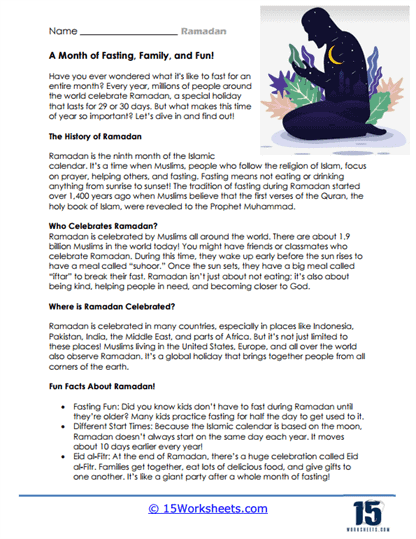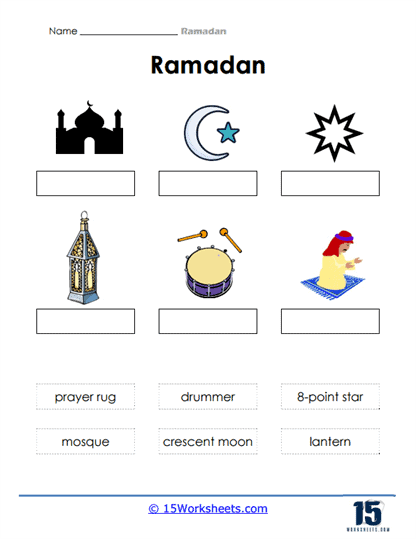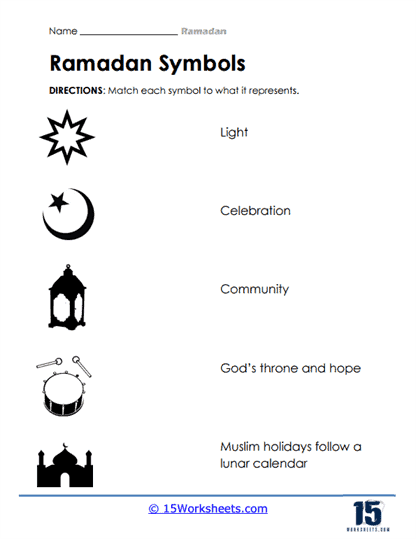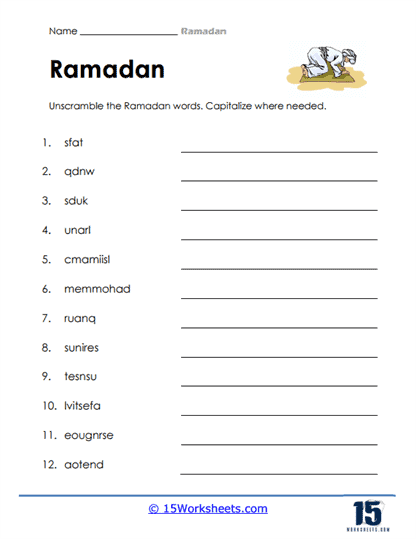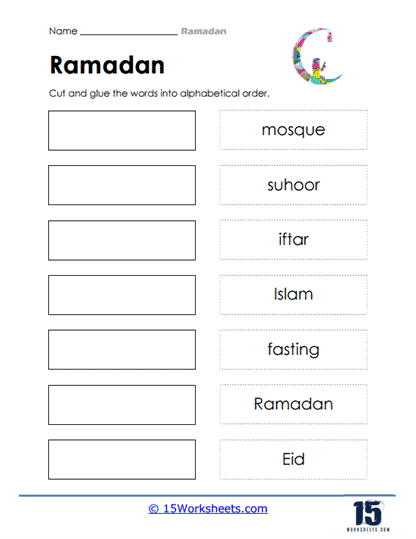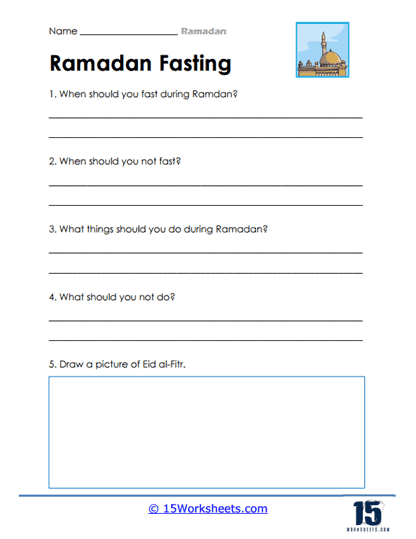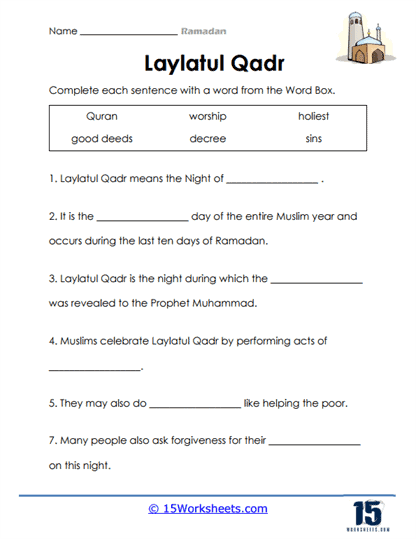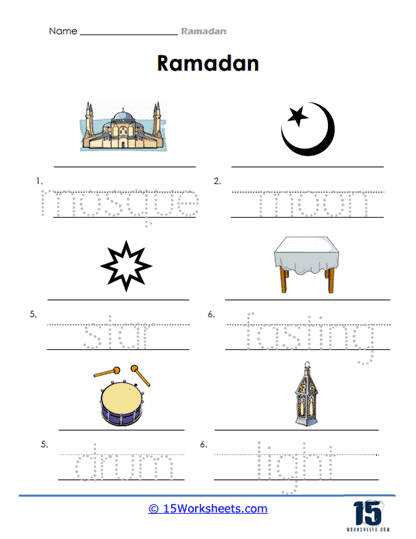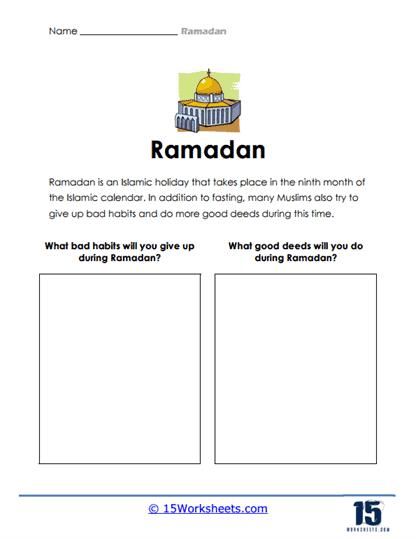Ramadan Worksheets
All About These 15 Worksheets
These worksheets help students, teachers, homeschoolers, and tutors explore and learn about the Islamic holiday of Ramadan in a structured and engaging manner. These worksheets combine religious education, cultural understanding, and interactive exercises, making them suitable for various age groups and learning environments. By using these worksheets, educators and learners can break down the key concepts of Ramadan, its significance, traditions, and customs, in a way that is both fun and informative.
The primary aim of these worksheets is to educate learners about the religious observance of Ramadan, which is celebrated by Muslims worldwide. They help students learn about important elements such as fasting, prayer, charity, self-reflection, and the overall importance of this holy month. These worksheets are useful in various settings, from classroom activities to homeschool lessons and even tutoring sessions. By presenting information in a visually appealing and easy-to-understand format, the worksheets make complex religious concepts more accessible.
The worksheets generally include a wide range of exercises that target different learning objectives. Based on the 10 images you’ve shared, it is clear that the collection of Ramadan worksheets offers a variety of activities designed to reinforce different aspects of the holiday. Here’s a breakdown of the different types of exercises you would typically find in these kinds of worksheets:
Reading Passages – Some worksheets include informative passages that describe the history, significance, and traditions of Ramadan. These passages are often accompanied by comprehension questions to ensure that students have understood the material. For example, one of the images includes a passage explaining how Muslims fast from sunrise to sunset, the role of prayer, and charity during Ramadan, and it ends with a cloze reading exercise, where students fill in the blanks with appropriate words.
Vocabulary and Word Matching – Ramadan worksheets often have vocabulary-building exercises where students learn key terms such as “Quran,” “Prophet,” “fast,” and “iftar.” Students might be asked to match symbols or words related to Ramadan with their meanings or definitions. An example from the images is a matching activity where symbols like a crescent moon or mosque are connected to their cultural or religious significance (e.g., light, community, celebration).
Symbol Identification – Many worksheets focus on symbols associated with Ramadan, such as the crescent moon, mosque, lantern, and prayer rug. Activities might involve labeling images or matching symbols to their meanings, allowing students to visually connect Islamic symbols with the holiday.
Fill-in-the-Blanks and Cloze Passages – Some worksheets feature cloze exercises where students complete sentences or paragraphs by adding missing words. These exercises reinforce reading comprehension and allow students to demonstrate their understanding of Ramadan traditions, such as fasting, prayers, and the celebration of Eid al-Fitr. One worksheet shows a cloze passage where students are prompted to fill in words like “fasting,” “charity,” and “good deeds.”
Unscrambling Words – Word puzzles, such as unscrambling Ramadan-related terms, help with vocabulary reinforcement and spelling practice. These fun and challenging activities also engage younger learners. In one of the images, terms like “fast,” “iftar,” and “sunrise” are scrambled for students to solve, making learning both interactive and enjoyable.
Sentence Completion with Word Banks – Another type of activity is sentence completion using a word bank. These exercises help students apply their knowledge in context by choosing the appropriate words to fill in the blanks. One worksheet image has a word box with options like “Quran,” “sins,” and “worship,” which students must use to complete sentences about Laylatul Qadr, an important night during Ramadan.
Reflection and Personal Contributions – Several worksheets prompt students to reflect on their own habits or actions during Ramadan. These might include spaces for students to write about what bad habits they will give up during Ramadan or what good deeds they plan to do, encouraging them to apply the principles of Ramadan to their daily lives. This promotes self-reflection and personal growth, which are key themes of the holiday.
Creative Drawing Exercises – Some worksheets encourage students to express their understanding of Ramadan through drawing. For example, a worksheet might ask students to draw a picture of Eid al-Fitr, the festival that marks the end of Ramadan, or create visuals of things they know about Ramadan. These activities tap into students’ creativity and allow for a more personalized learning experience.
Word Meaning Exercises – Understanding the meanings of key religious terms is another crucial aspect of Ramadan worksheets. Students are often asked to write definitions for terms like “Quran,” “Prophet,” and “fast,” helping them build a solid foundation in religious vocabulary.
Discussion and Writing Prompts – Lastly, many worksheets include questions or writing prompts designed to encourage discussions about Ramadan, its importance, and how it is observed. These questions help students think critically about the holiday, fostering a deeper understanding of its significance in the Muslim faith.
What is Ramadan?
Ramadan is one of the most important religious observances in Islam, celebrated by Muslims around the world. It is the ninth month of the Islamic lunar calendar, lasting 29 or 30 days depending on the sighting of the moon. Muslims believe that Ramadan is the month in which the Quran, the holy book of Islam, was revealed to the Prophet Muhammad. As a result, it is considered a deeply spiritual time focused on self-reflection, prayer, and community. Fasting from dawn until sunset is a key aspect of Ramadan, and it serves as an opportunity for Muslims to purify their souls, practice self-discipline, and strengthen their relationship with God.
The Practice of Fasting
Fasting, known as sawm, is the central practice during Ramadan. From sunrise (Fajr) to sunset (Maghrib), Muslims refrain from eating, drinking, smoking, and other physical needs. The fast begins before dawn with a pre-fast meal called suhoor and ends at sunset with a meal known as iftar. Fasting is not merely about abstaining from food; it also includes refraining from sinful behavior, such as lying, gossiping, and impure thoughts or actions. The fast is meant to teach self-control, empathy for the less fortunate, and a sense of spiritual renewal. However, exceptions are made for children, the elderly, the sick, pregnant or nursing women, and travelers, who are not required to fast if it would cause harm.
Spiritual and Religious Activities
Ramadan is a time of increased devotion and worship. In addition to fasting, Muslims engage in more frequent prayers, recitation of the Quran, and acts of charity. One of the special prayers during Ramadan is the Taraweeh, performed each night, which involves the recitation of long portions of the Quran. Many Muslims aim to read or listen to the entire Quran over the course of the month. Charity, known as zakat or sadaqah, is also emphasized during Ramadan, with many people donating money, food, or time to help those in need. This spiritual focus serves to cleanse the soul and deepen one’s faith, making Ramadan a sacred and transformative period.
The End of Ramadan and Eid al-Fitr
Ramadan concludes with the celebration of Eid al-Fitr, which marks the end of the fasting period. Eid al-Fitr is a joyous occasion, beginning with a special prayer held in the morning, followed by a communal meal and festivities with family and friends. It is customary to give zakat al-fitr, a charitable donation meant to help the poor and ensure that everyone can participate in the celebration. On this day, Muslims express gratitude to God for the strength to complete the month of fasting and reflect on the lessons of self-discipline, empathy, and generosity learned during Ramadan. The holiday also serves as a time for forgiveness and reconciliation within the community.
Global Impact
Ramadan is observed by over a billion Muslims across the globe, and it holds significant cultural, social, and economic importance in many Muslim-majority countries. Work hours are often adjusted, and the streets come alive after sunset with special meals and communal gatherings. Markets, mosques, and homes are decorated, creating a festive atmosphere despite the physical challenge of fasting. In non-Muslim countries, Ramadan helps to foster understanding and awareness of Islamic traditions, with interfaith iftar dinners and community events. For Muslims, regardless of location, Ramadan is a month of spiritual rejuvenation, reflection, and a renewed sense of community.

